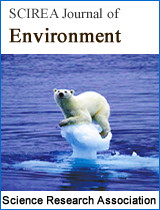Seabird and marine mammal distribution in the Amundsen Sea, Antarctica, 2010
DOI: 10.54647/environmental61211 142 Downloads 7458 Views
Author(s)
Abstract
Our long-term study on the quantitative at-sea distribution of the upper trophic levels - seabirds and marine mammals - in polar ecosystems aims at quantifying the factors influencing their distribution as well as detecting possible spatial and temporal changes, with special attention to hydrography and global climate changes. During the ANT- XXVI/3 expedition of icebreaking RV Polarstern in February-March 2010, a total of 8,270 seabirds belonging to 15 identified species were recorded in the Amundsen Sea during 1,070 half-hour transect counts, with a mean of eight birds per count. The most numerous species were by far Antarctic petrel (Thalassoica antarctica), Adélie penguin (Pygoscelis adeliae) and snow petrel (Pagodroma nivea), which together accounted for more than 80% of all individuals of these species recorded. Substantial hotspots of seabirds perched on three icebergs, representing 44% of all observations: 85% of the Antarctic petrels and 40% of the snow petrels (Joiris 2017). Without taking into account these data, the mean seabird number becomes five individuals per count, representing the lowest value registered in Antarctic seas. The most numerous pinniped was crabeater seal (Lobodon carcinophaga) contributing 98% of the total of 2,350 individuals of four pinniped species (Joiris and D’Hert 2015). Among cetaceans, the most abundant species were Antarctic Minke whale (Balaenoptera bonaerensis) and fin whale (B. physalus) (60% and 25% of the total of 170 individuals, four species). The maps allow for a visual comparison that is sufficient for the purposes of this paper, reflecting the influence of hydrological features such as water masses and fronts, pack ice and ice edge, free drifting icebergs.
Keywords
Seabirds, marine mammals, at-sea distribution, Amundsen Sea
Cite this paper
Misiani Zachary, Lun Yin, Mwai Zacharia, Antonine Sakwa, Xiaohan Zhang, Yanyan Zheng, Bousted Mukolwe,
Seabird and marine mammal distribution in the Amundsen Sea, Antarctica, 2010
, SCIREA Journal of Environment.
Volume 5, Issue 2, April 2021 | PP. 27-45.
10.54647/environmental61211
References
| [ 1 ] | T ADDIN Mendeley Bibliography CSL_BIBLIOGRAPHY Elia, Emmanuel F. 2014. “Indigenous Knowledge Use in Seasonal Weather Forecasting in Tanzania : The Case of Semi-Arid Central Tanzania.” 80(1): 18–27. |
| [ 2 ] | Guthiga, Paul, and Andrew Newsham. 2011. “Meteorologists Meeting Rainmakers : Indigenous Knowledge and Climate Policy Processes in Kenya.” 42(3). |
| [ 3 ] | Guto, Richard. 2021. “A Meta-Analytical Review of the Role of Indigenous Knowledge on Environmental Conservation and Climate Change in Kenya.” (January). |
| [ 4 ] | Nganyi, Obedi Osore, Obedi Osore, and Obedi Osore. 2010. “Meet Obedi Osore : Rainmaker.” (April). |
| [ 5 ] | Okonya, Joshua S, and Jürgen Kroschel. 2013a. “Indigenous Knowledge of Seasonal Weather Forecasting : A Case Study in Six Regions of Uganda.” (June 2014). 2013b. “Indigenous Knowledge of Seasonal Weather Forecasting : A Case Study in Six Regions of Uganda.” 4(12): 641–48. |
| [ 6 ] | Onyango, Maria. 2019. “Reconstruction of Agricultural Calendar Lessons from Western Kenya : Crops , Cultural Events , Astronomy and Recurrent Climate Events and Recurrent Climate Events.” Les Cahiers d’Afrique de l’Est / The East African Review [Online], 52(May): 127–50. |
| [ 7 ] | Onyango, Maria, and Maria Onyango. 2019. “Reconstruction of Agricultural Calendar Lessons from Western Kenya : Crops , Cultural Events , Astronomy and Recurrent Climate Events and Recurrent Climate Events.” (May). |
| [ 8 ] | Ouma, Gilbert. 2015. “Community-Based Climate Monitoring Services and Early Warning System : The Case of the Nganyi Community UNISDR Scientific and Technical Advisory Group Case Studies - 2014 Community-Based Climate Monitoring Services and Early Warning System : The Case of the Nganyi Community The Problem.” (January). |
| [ 9 ] | Rautela, Piyoosh, and Bhavna Karki. 2015. “Weather Forecasting: Traditional Knowledge of the People of Uttarakhand Himalaya.” Journal of Geography, Environment and Earth Science International 3(3): 1–14. |
| [ 10 ] | Rautela, Piyoosh, Disaster Mitigation, Management Centre, and Bhavna Karki. 2016. “Weather Forecasting : Traditional Knowledge of the People of Uttarakhand Weather Forecasting : Traditional Knowledge of the People of Uttarakhand Himalaya.” (January 2015). |
| [ 11 ] | Risiro, Joshua, Dominic Mashoko, T Tshuma, and Elias Rurinda. 2012. “Weather Forecasting and Indigenous Knowledge Systems in Chimanimani District of Manicaland , Zimbabwe.” 3(4): 561–66. |
| [ 12 ] | Rundio, Al. 2016. “Stories From the Field.” Journal of addictions nursing 27(4): 261. Weather, Contextual. “Council for Innovative Research.” 7(2): 1000–1008. |
| [ 13 ] | Zuma-netshiukhwi, Gugulethu, Kees Stigter, and Sue Walker. 2013. “Use of Traditional Weather/Climate Knowledge by Farmers in the South-Western Free State of South Africa: Agrometeorological Learning by Scientists.” : 383–410. |

